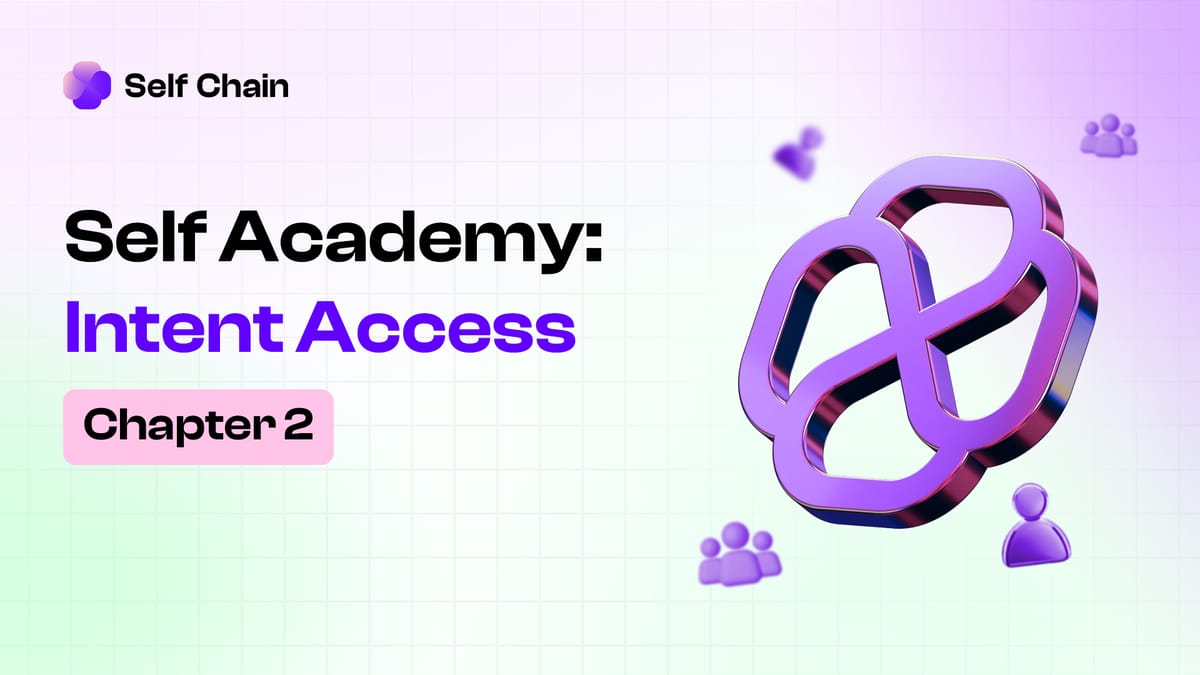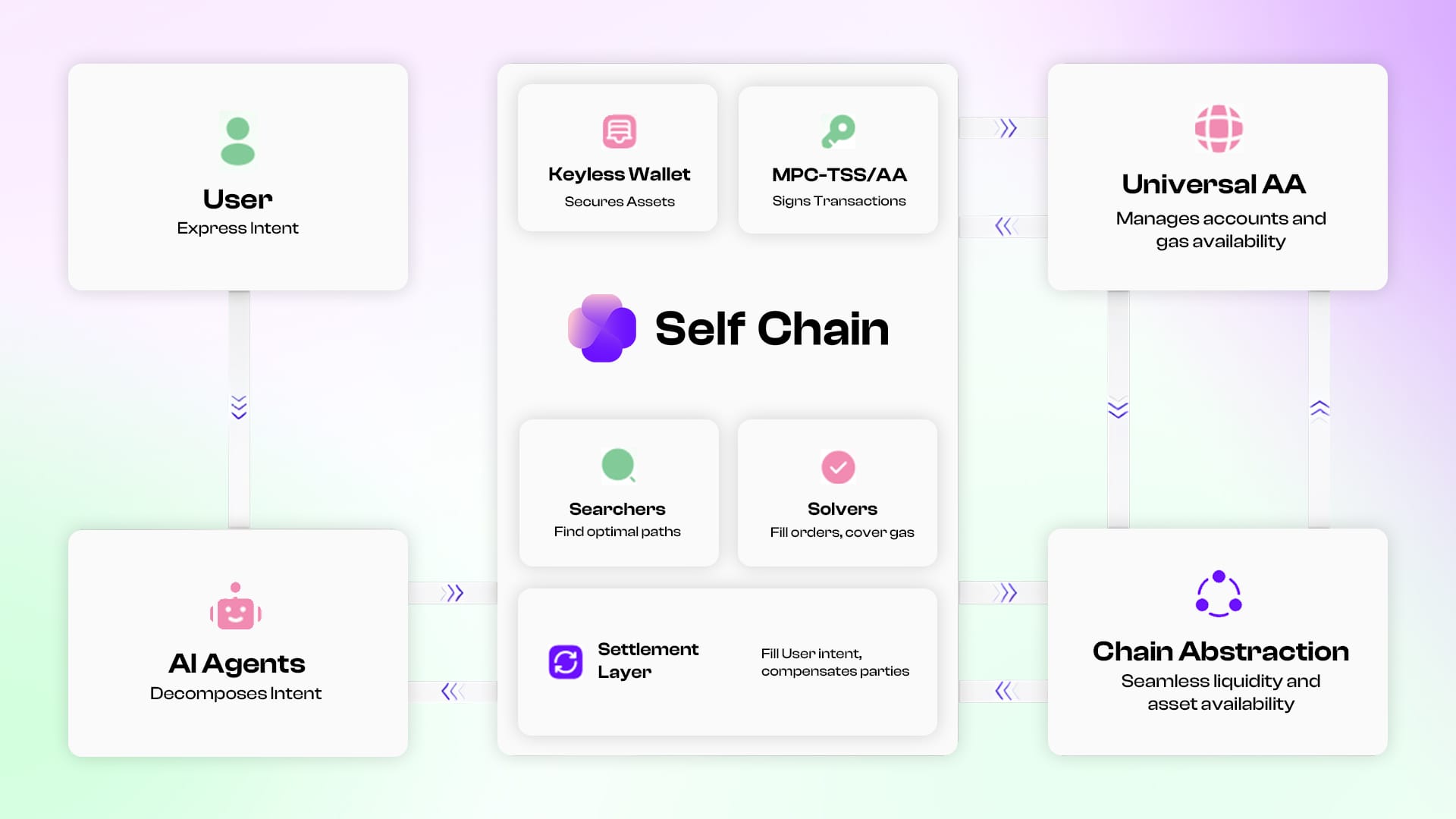SELF ACADEMY: INTENT ACCESS

Introduction: Why Web3 User Experience is Broken
Web3 has made incredible strides over the last decade, offering financial sovereignty, open digital ownership, and global permissionless networks. Yet, despite this promise, mainstream adoption remains elusive.
The reason isn't a lack of innovation. It’s user experience.
Today, interacting with blockchain applications demands:
- Managing private keys and wallets
- Approving complex transaction strings
- Understanding gas fees, slippage, bridges, and chain IDs to avoid mistakes
- Handling transaction failures manually
For the vast majority of users, these barriers make Web3 feel foreign and intimidating. Even seasoned users feel the weight of micromanaging DeFi swaps, NFT mints, staking operations, and cross-chain movements.
The real bottleneck is not technology. It’s access.
To move beyond today's limits, Web3 needs to evolve from manual interactions to intent-driven experiences, where users simply express what they want in the simplest language, and the network performs the command.
This is where Intent Access emerges as the next critical infrastructure layer for Web3.
What are Intents?
An intent represents a user's desired outcome on the blockchain, expressed without prescribing the exact steps required to achieve it.
Instead of manually constructing transactions — selecting a DEX, setting slippage tolerance, approving tokens, bridging assets — the user communicates his goal in simple language:
“Swap 500 USDC into the highest-yielding stablecoin pool across any chain.”
An intent does not dictate:
- Which DEX to use
- Which bridge to cross
- Which sequence of smart contracts to touch
It abstracts away the pathfinding process, allowing decentralized networks of searchers and solvers to determine the most efficient, secure, and cost-effective method to fulfill the request.
Life Cycle of An Intent
A technical system that supports Intent Access orchestrates the full life cycle of an intent from submission to settlement. This journey unfolds across four key infrastructure layers, captured in what we would call the CAKE Framework:
1. Intent Declaration (Application Layer)
The user expresses a goal via an interface of either a dapp or AI agent, capturing the objective which could be: "Swap USDC for ETH".
At this stage, the Application layer captures the user intent in a structured, AI-readable format. It abstracts away the blockchain complexity, enabling the user to express their goals in natural language.
2. Intent Broadcasting (Permission Layer)
The captured intent is broadcast to a decentralized network of searchers and solvers. But before execution, it must be verified.
This is where the permission layer comes in. It proves the validity of the submitted intent by checking if it aligns with the user’s authorization policies.
Technologies like keyless wallets and account abstraction ensure that intents are signed and validated securely without exposing user’s private keys.
3. Intent Matching and Solving (Solver Layer)
Solvers scan across blockchains, liquidity pools, and protocols to: Find feasible paths, optimize for user goals and constraints, and prepare candidate transaction bundles.
4. Intent Execution & Settlement (Settlement Layer)
Once the best path is found:
- A transaction bundle is signed (could involve MPC-TSS signatures, batched signatures, account abstraction).
- Execution occurs atomically (either fully successful or safely reverted).
Essentially, the user receives the final outcome (e.g., swapped tokens, staked position) which can be accessed directly within their wallet or application interface. At this point, the user interaction is complete without needing to know the series of underlying transactions, signatures, or liquidity pathways involved.
Self Chain: Native Implementation of Intent Access

Self Chain is a purpose-built L1 with a modular, production-ready infrastructure built specifically for Intent Access. Instead of simply replicating capture, permission, solving, and settlement, Self Chain embeds key innovations at every layer of the intent lifecycle to make execution seamless, autonomous, and multi-chain by default.
At the start, Users can express intents like "stake assets across chains" or "find the best yield opportunities", without manually constructing transactions. AI Agents operating within Self Chain's environment can decompose these intents into actionable objectives, preparing them for efficient solving.
Keyless Wallets, powered by MPC-TSS and Account Abstraction, manage secure asset control and transaction signing without exposing users to private key management risks. This programmable account model ensures that even autonomous agents can authorize complex operations safely and trustlessly.
Searcher networks scan across liquidity pools, bridges, and blockchains to find optimal execution paths, while Solvers prepare transaction bundles, fill orders, and even cover gas costs where necessary, ensuring users receive optimal outcomes without micromanaging tradeoffs.
Self Chain's Account Abstraction (AA) layer standardizes account operations across chains, managing gas payments and simplifying wallet interactions. Meanwhile, Chain Abstraction enables seamless liquidity access and asset availability across different blockchains, eliminating the traditional friction of cross-chain movement.
The Settlement Layer guarantees atomic, verifiable fulfillment of user intents. Transactions are finalized securely, with solvers compensated for their role in realizing user goals, and users receiving outcomes without worrying about bridges, routers, or manual confirmations.
Through this architecture, Self Chain transforms Web3 from a transaction-driven experience into a true goal-driven ecosystem, where users and agents simply express what they want, and the network does the rest.
Conclusion
Intent Access marks a critical evolution for Web3, shifting the user experience from manual transaction micromanagement to simple goal expression. By building infrastructure specifically for intents, Self Chain enables a future where users, agents, and applications interact with blockchain effortlessly. As decentralized systems grow more complex, Self Chain provides the foundation for a streamlined, accessible, and truly autonomous Web3.
About Self Chain
Self Chain is the AI-powered intent layer for Web3, and a Modular L1 simplifying blockchain interactions. By combining keyless wallets (MPC-TSS/AA), intent-driven automation, and seamless multi-chain access, Self Chain eliminates complexity, making Web3 more intuitive, autonomous, and secure.
With Keyless Wallets and AI-powered intent execution, users can seamlessly onboard, manage assets, and interact with dApps without handling private keys or complex transactions. Self Chain’s AgentFi Infra enables autonomous on-chain AI agents to execute transactions, optimize DeFi strategies, and interact across ecosystems, while PayFi powers seamless, real-time blockchain payment systems, aligning with the evolving demands of the emerging global economy. Developers benefit from tools like the Intent SDK, Keyless Wallet SDK, and Account Abstraction Plugins, enabling the next generation of AI-driven applications with enhanced security and efficiency.
